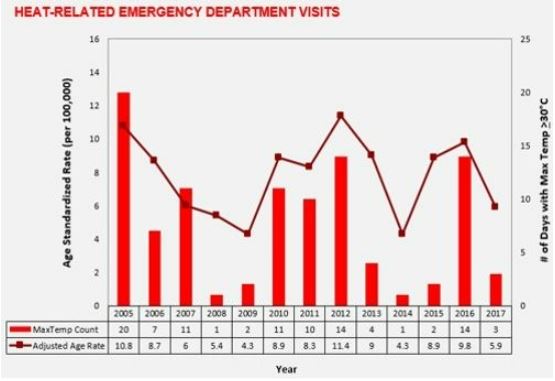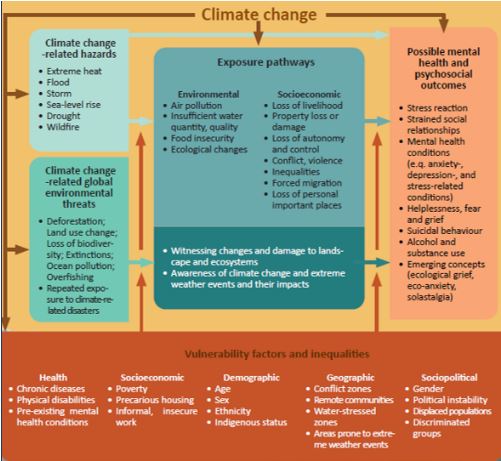Top takeaways:
- The increase in temperature and extreme heat days in Ontario will expose employees to conditions that can increase physical and mental stress on the body to a dangerous or irreversible state.
- Employees in a variety of industries are particularly vulnerable to extreme heat-related illness and dangers, including agriculture, construction, and businesses that operate in unconditioned indoor spaces.
- Businesses will need to consider the risks of extreme heat days and adjust their operations and budget accordingly to consider an increased need in employee benefits, health and safety training, PPE, and climate-controlled spaces.
What does extreme heat do to people?
This is of particular concern for industries with high outdoor heat exposure risks, such as agriculture and construction. Such impacts may also be of concern in unconditioned interior spaces as seen in restaurants, commercial laundries, some shop floors, and warehouses, etc. Extreme heat has also been linked to mental health impacts, with exposure to extreme heat and humidity associated with higher deaths amongst people with pre-existing mental conditions and increased suicide rates[2].
In Canada, extreme heat has proven to be deadly. Previous extreme heat events in British Columbia and Quebec have led to the loss of life, with 619 heat-related deaths attributed to B.C.’s extreme heatwave of July 2021[3] and 291 and 86 deaths occurring in Quebec’s extreme heatwaves of 2010 and 2018, respectively[4]. TRCA climate change projections for the Toronto region suggest that the number of extreme heat days with temperatures above 30°C are likely to be between 22 – 31 days by the 2050s and 37 – 41 days by the 2080s, compared to the historic average of 11 days. While the number of extreme heat days are counted in Ontario, heat-related deaths are not. This data gap is a result of inadequate tracking protocols like those that exist in Montreal and Quebec that consider heat-related co-morbidities[5].
The Medical Dangers of High Humidity
With the occurrence of extreme heat events expected to increase in frequency, duration, and severity over this century, many public health officials are placing more emphasis on the parameter of wet-bulb temperature, which is the lowest temperature that air can be cooled by the evaporation of water[6]. Above a wet bulb temperature of 35°C, the body loses its ability to cool itself through sweating which can ultimately lead to the failure of internal organs and systems. Wet bulb temperature considers both humidity and temperature and is of primary concern for industries with high exposure risks (e.g., agriculture and construction) in regions with high humidity or near large bodies of water such as the Great Lakes region. A global study in 2020 found that global occurrence and severity of extremely humid heat has increased over the past 40 years and is expected to continue increasing with models projecting wet bulb temperatures above 35°C in South Asia, the Persian Gulf, and the Red Sea by around 2050; and Eastern China, parts of Southeast Asia, and Brazil by 2070[7].

How does climate change impact mental health?
It was noted that extreme heat can impact mental health. Climate change also amplifies social and environmental risk factors for mental health. These include air quality, water quantity and quality, food security and safety, income and livelihoods, ecosystem changes and others. These risks are disproportionately felt by groups and individuals that have increased vulnerability due to health, socioeconomic, demographic or other inequalities. Some examples of mental health impacts resulting from climate change are:
- Stress reactions
- Stress-related physical health problems
- Depression, anxiety and other mental health conditions
- Strained social relationships
- Helplessness, fear and grief
- Increased risk of suicidal behaviour[8]
In addition to increased mental health stressors from direct exposure to climate change events, such as flooding, fires and extreme heat, the scale of the global challenge we are facing can cause distress in and of itself.

What diseases can we expect to see more of?
Warming temperatures and changing precipitation patterns can also increase the suitable range and spread of vector-borne diseases such as West Nile Virus and Lyme Disease[9]. Over the last two decades, Canada has already seen the occurrence of mosquito-borne diseases increase by 10%, which is largely attributed to climate change and warming temperatures[10]. Climate change is also expected to allow other mosquito species to move further north into Canada, potentially carrying new diseases that are not common in the region such as Chikungunya virus, dengue, and Zika virus[11]. With temperature and precipitation projected to increase in the Toronto region over this century, the need to protect employee health and safety from vector-borne illnesses, particularly those who work outdoors, will likely continue to increase.
What does this mean for businesses?
Climate change has significant implications for human health and therefore the productivity of businesses that depend on a healthy workforce. Businesses may see:
- Lost workdays due to heat related illness, especially for those organizations with significant exposure and vulnerability to outdoor environmental conditions or unconditioned interior spaces.
- Increased air conditioning needs and the resulting costs, which may be affected by rising energy prices.
- Lost workdays and the need to increase employee supports due to mental health stressors caused by extreme heat and the impacts of climate change.
- The need to increase staffing to accommodate climate change related workforce capacity requirements.
- Increased employee training and awareness of the risks of vector borne disease, along with securing appropriate personal protective equipment (PPE).
- Policy and regulation updates to health and safety protocols.
Bottom Line
Climate change has significant implications for human health and therefore the productivity of businesses that depend on a healthy workforce. There is a risk of lost workdays due to heat related- illness, especially for employees who work in outdoor environmental conditions or spaces without air conditioning. The increase in air conditioning demands will increase energy demands and expenses, something that businesses must forecast and budget for.
An increase in climate-related illnesses and hazards will also increase the need for more employee resources. This includes mental and physical health programs, and additional employee training to raise awareness of the health and safety risks associated with climate change. To account for changes in workforce capacity, businesses may need to increase staffing and shift scheduling to ensure work can still be completed within timeframes and a capacity that keeps employees healthy and safe.
Partners in Project Green’s Building a Climate Resilient Business Resource Kit provides a foundation in the basics of current climate science, the impacts of climate change on businesses, and mitigation and adaptation strategies. Please explore these resources and connect with us to advance your organization’s climate resiliency.
For more information on climate change mitigation and adaptation from a business perspective:
Mitigation
- Energy Efficiency and Conservation
- Fuel Switching
- Heat Recovery
- Carbon Capture, Utilization and Sequestration/Storage
- Low Carbon Transportation
- Behaviour Change
Adaptation
- Risk Identification
- Risk Analysis
- Risk Evaluation and Prioritization
- Implementation of Risk Interventions
- Monitoring and Review
[1] World Health Organization (WHO). 2018. Heat and Health. Accessed August 22, 2022. Click here for URL
[2] Charlson, F., Ali, S., Benmarhnia, T., Pearl, M., Massazza, A., Augustinavicius, J., and Scott., J.G. 2021. Climate change and mental health: a scoping review. International Journal of Environmental Research and Public Health. 18(9), 4486. Click here for URL
[3] Report to the Chief Coroner of British Columbia. 2022. Extreme Heat and Human Mortality: A Review of Heat-Related Deaths in B.C. in Summer. 2021. BC Coroners Service.
[4] Than Ha, T. 2021. What we can learn from Quebec’s deadly heat wave in 2018. Accessed August 22, 2022. Click here for URL
[5] Oved, M.C. 2019, Life and Death Under the Dome. Undeniable: Canada’s Changing Climate. The Star. Click here for URL
[6] Buis, A. 2022. Too Hot to Handle: How Climate Change May Make Some Places Too Hot to Live. Accessed August 22, 2022. Click here for URL
[7] Raymond, C., Matthews, T., and Horton, R.M. 2020. The emergence of heat and humidity too severe for human tolerance. Science Advances. 6, 19. DOI: 10.1126/sciadv.aaw1838
[8] Mental Health and Climate Change: Policy Brief, WHO, 2022
[9] Paz. 2015. Climate Change Impacts on West Nile Virus Transmission in a Global Context. Philosophical Transactions of the Royal Society B: Biological Sciences 370:1–11. Click here for URL
[10] Ludwig, A., Zheng, H., Vrbova, L., Drebot, M.A., Iranpour, M., and Lindsay, L.R. 2019. Increased risk of endemic mosquito-borne diseases in Canada due to Climate Change. Canada Communicable Disease Report. 45(4):91-97. Doi: 10.14745/ccdr.v45i04a03
[11] Ogden, N.H., Milka, R., Caminade, C. et al. Recent and projected future climatic suitability of North America for the Asian tiger mosquito Aedes albopictus. Parasites Vectors 7, 532 (2014). Click here for URL

